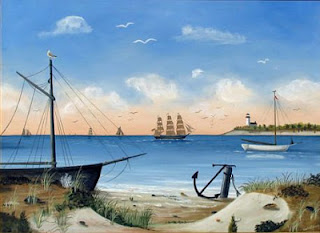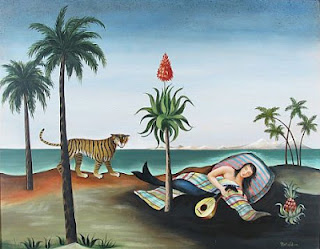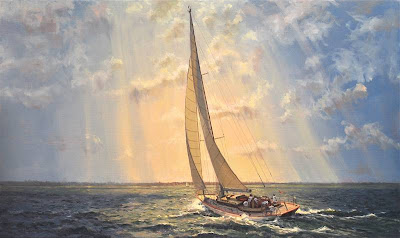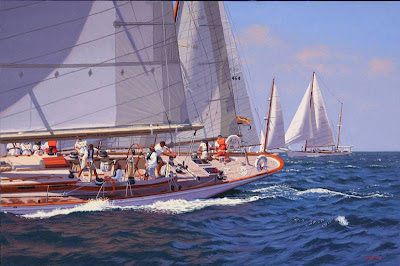SPECIAL EXHIBIT OF WORKS BY RALPH & MARTHA CAHOON
Ralph Eugene Cahoon Jr. (1910-1982) was descended from 17th-century
Scottish immigrants who settled in the Cape Cod town of Chatham in the
seventeenth century. Many of his ancestors were whalers and fishermen,
men who made their living off the sea. His maternal grandfather was an
oysterman. But Ralph always showed a bent for drawing. As a high school
student he'd enjoyed taking a correspondence course in cartooning. His
only other formal art training consisted of two years at the School of
Practical Art in Boston, a course of study interrupted by the
Depression. But his career took an unexpected path when, in 1930, he met
Martha Farham (1905-1999) at a dance in Chatham.
The daughter of Swedish immigrants, Martha was born in the Roslindale
section of Boston, then spent her early years growing up in Hyde Park.
Her family moved to Harwich on the Cape when she was ten. Her mother had
a green thumb and raised many crops for the family's use. Her father,
Axel Farham, was a talented furniture decorator who had learned the art
back in Sweden. Although Martha's teachers encouraged her to go to
college, she chose to apprentice to her father. Over the next ten years,
she learned to sand, scrape and stencil furniture and became very adept
at decorating with flowers.

After Martha married Ralph in 1932, she taught him to decorate
furniture. They quickly bought a small home in Osterville and were
selling their pieces, along with antiques, by the following summer.
Drawing upon the Swedish, Pennsylvania-German and American folk
traditions, they decorated tables, chairs, dressers and chests, as well
as smaller items like tin trays and wooden bowls. Even during the
Depression it was a good location because the village attracted many
wealthy summer residents and tourists. The Cahoons' only child, a son
named Franz, was born in 1935. During World War I, Ralph did painting of
another sort, painting battleships at the shipyard in Quincy.

When the war ended, Ralph realized a longtime dream by buying a large
historical home that would give him and Martha more room for showing
their furniture and antiques. They moved into a 1775 Crocker homestead
(the building that's now the Cahoon Museum of American Art) in the
neighboring village of Cotuit in 1945 and lovingly restored it. Ralph
began doing many large case pieces, including secretaries and cupboards,
that allowed him to really show off and expand his talents as a
decorator. Eventually, he and Martha began to paint many folk designs of
their own invention. Ralph often gravitated to scenes with sailors and
mermaids. Martha painted them, too, but especially loved country scenes
and such natural motifs as flowers, shells and birds.

In 1953, one of the Cahoon’s customers, art patroness Joan Whitney
Payson, convinced the couple to frame some of their scenes for her to
exhibit at the Country Art Gallery, a new business she was opening on
Long Island. The paintings sold at once, and the Cahoons had their
first two-person show at the gallery in 1954 (plus many more in the
years that followed). By 1960, Ralph and Martha were also showing
regularly at the Lobster Pot Gallery on Nantucket and Palm Beach
Galleries in Palm Beach, Florida, and were being invited to show at
other galleries around the country. In particular, an exhibition at Vose
Galleries of Boston toward the end of 1960 did much to enhance their
reputation. By this time, Ralph's polished style was all but synonymous
with mermaids. Typically, his scenes had New England seaside settings,
often with a lighthouse on a spit on the horizon, a clipper ship out on
the water and a hot-air balloon or two in the sky. His slightly raunchy
wit won many enthusiasts. Using a somewhat more muted palette and a
gentle playfulness, Martha charmed her admirers with nostalgic country
scenes and pictures of shorebirds in their natural habitat. During the
Sixties and Seventies, the Cahoons' work was collected by such notables
as Jacqueline Kennedy (who drove over to their studio from the Summer
White House in Hyannis Port), Jean Kennedy Smith, Maxim Karolik,
Marjorie Merriweather Post, Lily Pulitzer, Joan Fontaine, and several
members of the Mellon and duPont families.

Around 1970, the Cahoons pulled back from demands of exhibiting at
commercial galleries, preferring to sell their paintings only from their
own studio. They were something of local legends by that time and had
no trouble attracting clients. One particularly enthusiastic local
collector was Josiah K. Lilly III, an heir to the pharmaceutical
fortune. He and his wife, Josephine, collected dozens of Ralph's
paintings, many done on commission. Lilly also acquired several
collections of Americana, including antique automobiles, and founded
Heritage Plantation of Sandwich (now Heritage Museums and Gardens) for
the display of his collections in the late Sixties. When an art museum
opened at Heritage in the early Seventies, the Cahoons were given the
first show. In the late 1970s, Ralph encouraged his friend Bernard
Woodman to create sailors' valentines, and the two of them collaborated
on any number of pieces pairing a painting of Ralph's with Bernie's
shellwork. Martha found a new theme in the "Garden of Eden," which
allowed her to paint animals to her heart's content.

Martha was 77 when Ralph died in 1982. She sold their home to
Rosemary Rapp, a local art collector who transformed it into a museum
named in the Cahoons' honor and granted Martha life-time rights to live
in four rooms on the ground floor. Although Martha stopped painting a
year or two after Ralph died, she continued drawing pictures with
crayons and colored pencils, many of them of mermaids. Although she
vowed to stop on many occasions, she never could. Her final drawing
dates from just a few weeks before her death in December 1999 at age 94.
Ralph and Martha Cahoon are
the most famous folk artists the Cape has ever produced, and Ralph the
best-known of any native Cape Cod artist.














